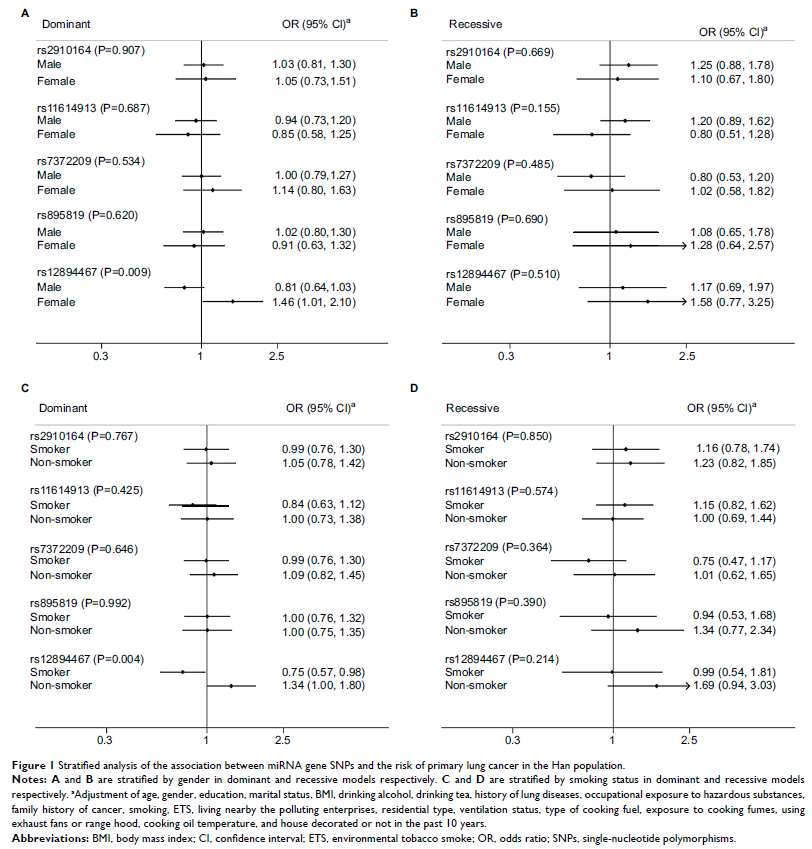108605
论文已发表
注册即可获取德孚的最新动态
IF 收录期刊
- 3.4 Breast Cancer (Dove Med Press)
- 3.2 Clin Epidemiol
- 2.6 Cancer Manag Res
- 2.9 Infect Drug Resist
- 3.7 Clin Interv Aging
- 5.1 Drug Des Dev Ther
- 3.1 Int J Chronic Obstr
- 6.6 Int J Nanomed
- 2.6 Int J Women's Health
- 2.9 Neuropsych Dis Treat
- 2.8 OncoTargets Ther
- 2.0 Patient Prefer Adher
- 2.2 Ther Clin Risk Manag
- 2.5 J Pain Res
- 3.0 Diabet Metab Synd Ob
- 3.2 Psychol Res Behav Ma
- 3.4 Nat Sci Sleep
- 1.8 Pharmgenomics Pers Med
- 2.0 Risk Manag Healthc Policy
- 4.1 J Inflamm Res
- 2.0 Int J Gen Med
- 3.4 J Hepatocell Carcinoma
- 3.0 J Asthma Allergy
- 2.2 Clin Cosmet Investig Dermatol
- 2.4 J Multidiscip Healthc

miR-300 rs12894467 多态性可能与中国汉族人群原发性肺癌的易感性有关
Authors Liu Z, Lin Y, Kang S, Xu Q, Xiong W, Cai L, He F
Received 27 April 2018
Accepted for publication 30 June 2018
Published 17 September 2018 Volume 2018:10 Pages 3579—3588
DOI https://doi.org/10.2147/CMAR.S172514
Checked for plagiarism Yes
Review by Single-blind
Peer reviewers approved by Dr Colin Mak
Peer reviewer comments 2
Editor who approved publication: Professor Nakshatri
Objective: The etiology of lung cancer has been attributed to both
environmental and genetic factors. In this study, we investigated the
association between five miRNA gene single-nucleotide polymorphisms (SNPs) and
the risk of lung cancer, and explored the interaction between genetic and
environmental factors in the Han people of China, the ethnic group that
represents >90% of the population of the country.
Methods: This case–control study included 1,067 cases and 1,085 controls.
Epidemiological data were collected by in-person interviews using a standard
questionnaire. Matrix-assisted laser desorption/ionization time of flight mass
spectrometry was applied to genotype the selected miRNA gene SNPs.
Unconditional logistic regression and stratified analysis were used to analyze
the associations between these SNPs and lung cancer, and to calculate the
adjusted odds ratios (ORs) and 95% confidence intervals (CIs). Crossover
analysis, logistic regression, and the Excel table made by Andersson were used
to analyze the combined and interaction effects of gene–environment.
Results: The rs12894467 CC/CT genotype was associated with a significantly
increased risk for lung cancer in women (adjusted OR =1.46, 95% CI=1.01–2.10).
Smokers carrying the CC/CT genotype were associated with a significantly
decreased risk of lung cancer, the adjusted OR was 0.75 (95% CI: 0.57–0.98). In
the dominant model, rs12894467 and gender were associated with a positive
multiplicative interaction; rs12894467 and smoking were associated with a
negative multiplicative interaction.
Conclusion: The rs12894467 polymorphism was potentially associated with
primary lung cancer in the Han Chinese population and had an interactive
relationship with environmental factors.
Keywords: microRNAs, single-nucleotide polymorphism, lung cancer,
case–control studies, susceptibility
